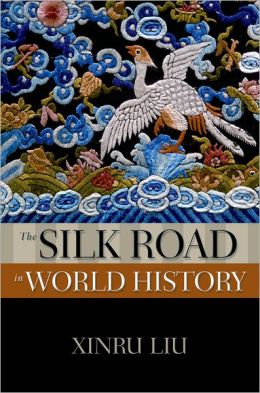I just finished reading The Silk Road in World History by Xinru Liu. What do you say about a book that discusses the history of an institution that spreads across Eurasia and lasted more than 1000 years, and does so in 126 pages?
Today we are used to global trading networks, but the silk road existed a couple of thousand years ago. There were other large scale trading networks developed in the distant path, including in the native American societies before Columbus and that of the Hanseatic League. However, the silk road is exists deep in our historical consciousness and there is considerable knowledge about it, both from written sources and archaeological ones.
The book makes clear that there were many paths taken by trade goods in what was called "the silk road", including sea trade. Many goods were traded, many cultures participated in the trade, and it was conducted under the rules of many different cultures. The technology of transport varied, as did the cultural context of what was happening.
If you think about it, trade depends on certain conditions. Children trading toys understand one -- each child has to want the other's toy more than his/her own for the trade to take place. For trade to take place over great distances, the profits from the exchanges have to pay for the costs of transport and the risks that are run.
Silk was a great trade good. It was first produced only in China. The growing of silk worms could only be done successfully in certain areas, and needed certain plants for the worms to feed on. Drawing silk thread from the cocoons, spinning the silk thread, and weaving the silk garments involved technological problems that were difficult a couple of thousand years ago. So too did dying the silk in the preferred colors, but when properly died the silk was especially beautiful. Weaving the brocades that were seen as especially beautiful was even more difficult. Silk robes were pleasant to wear. Common people could see that the people wearing them were richer and more powerful than almost everyone else. Silk was relatively light and did not break; it was relatively easy to transport by horse, camel or ship. Rich people who lived far from where silk was produced were willing and able to pay a lot, trade a lot, to get silk garments. Eventually silk was acquired to adorn places of worship and palaces to show their importance.
Other trade goods included gold and silver, precious stones, aromatic materials, dyes, horses and camels (which transported themselves), and later tea, spices and fine pottery.
The Han Rulers of China traded silk for fine horses (which they no doubt valued in part for the display that they made before the common folk). The rulers of the people to the west that had the fine horses were willing to trade for silk garments (which they no doubt valued in part for the display that they made before the common folk). The Chinese reduced the risks of conducting the trade by conducting it in the protection of the great wall of China and the troops that maintained order within the protection of the wall. The rulers in both cases were able to extract wealth from the people that they ruled.
The Romans as they extended their domain to the east provided safety for traders in their domain through the Pax Romana. Roman society produced a market for the silks from Asia and other trade goods, and had goods that in turn were valued in Asia. In Persia, Arabia and other lands through which the trade passed, other means were used to reduce the risks of the trade. Eventually, the spread of Islam provided safe passage for Muslim traders through the different Islamic kingdoms.
Author Xinru Liu describes
- how oasis communities grew as caravan stops in the Asian deserts, and how their markets came to play a role in the trade routes
- how Buddhist monasteries provided safe havens for traders in Asia, and how the network of Buddhist save havens grew over time.
- how improvements in ship building and sailing technology led to increased use of shipping, and thus to the potential for new trade goods to be moved by sea.
He describes how the mongol empire looted the peoples that it conquered, thereby obtaining the wealth with which to acquire the trade goods its rulers increasingly coveted. (I was surprised to learn that it was the Mongols who made carpets and tapestries a fashion as they introduced the furnishings of their tents into the palaces and fortifications that their empire allowed and required.) The breakup of Mongol solidarity is described as increasing the risks of trade and eventually leading to the fall of the silk route trade (not the fall of Constantinople to the Ottomans).
The book also describes how ideas migrated along the trade routes. Buddhism is described as moving along the silk road, especially after giving to Buddhist monasteries was introduced as a way of obtaining religious merit. So too, the Mongols were described as moving whole communities of artisans capable of producing the goods that the Mongols had come to value, thereby spreading the technology that they had mastered.
All in all I value the big picture provided by this book in its concise format. I won't remember all the details, but I hope to have learned some fundamental things about the growth of multinational institutions and the transfer of ideas as seen in historical time.



No comments:
Post a Comment